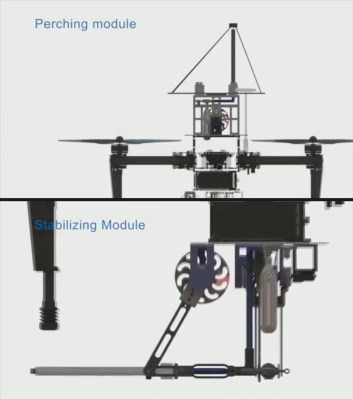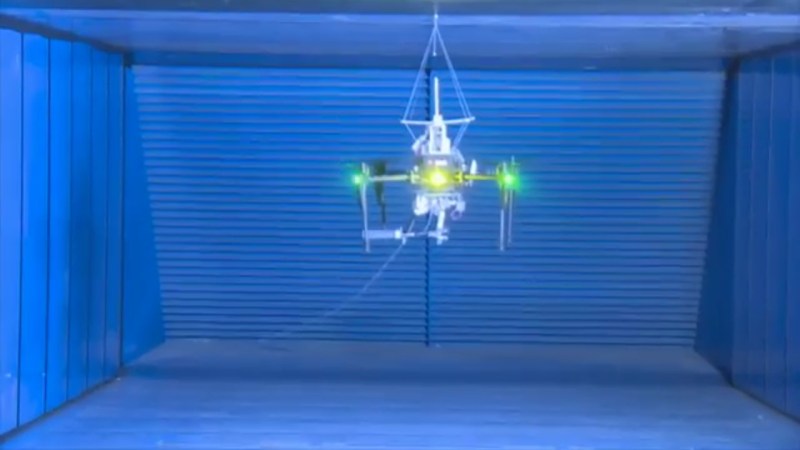Introducing your friendly neighborhood SpiderMAV, a micro aerial vehicle that shoots webbing to enable it to hang from ceilings and stabilize itself horizontally using low power. It’s inspired by the Darwin’s bark spider that spins a circular web with anchor lines up to 25 meters (82 feet) long.

For the DJI Matrice 100 drone to hang from a ceiling, a compressed gas cylinder fires a magnet with a trailing polystyrene line up to a steel beam. The line can then be reeled in to the desired length. For horizontal stabilization, line-trailing magnets are fired horizontally instead and then reeled in to tension the lines.
To test the effectiveness of the system, a cross wind was produced using a fan. With the DJI’s attitude-hold mode, maximum X, Y and Z deviations were 136, 386 and 106 mm respectively. With the stabilization, however, the deviations were reduced to 47, 80 and 74 mm. The power requirements were also reduced to essentially nil. Watch it in action in the videos below.
SpiderMAV is the brainchild of Imperial College London’s Aerial Robotics Laboratory, led by [Mirko Kovac], and is still experimental. For example, a magnet release mechanism has yet to be built in. Perhaps a sharp tug by the reeling mechanism, or a sudden thrust by the drone would release the magnets. Or the permanent magnets could be replaced with electromagnets, provided the required current doesn’t offset the efficiency gains. What solutions can you come up with? Let us know in the comments.
If, on the other hand, you want to turn yourself into Spider-Man then check out this four-limb wall-climbing mechanism using microwave oven transformers followed by the also necessary electromagnetic web shooter.
















Can it play the theme song while hanging around?
It could use permanent magnets for the hold, and burst a reverse polarity electromagnet to release. Seems like the best of both worlds to me.
Sort of like an Electropermanent magnet?
https://en.m.wikipedia.org/wiki/Electropermanent_magnet
Spider drone, spider drone. Does whatever a spider drone can!
Spins a web, can hang from it. Cuz that’s what all spiders do.
Reversing the polarity of a magnet doesn’t make it repel from ferrous objects though. Only other magnets with the same pole pointing towards them after the polarity is reversed..
An electropermanent magnet is a permanent magnet spiced up with coils counteracting the field, so it is energized to disable the magnet momentarily, so it does work on ferrous surfaces. Funny thing is that multiple hackers instantly thought of them when they saw this video, including myself. This bears witness to how a well tuned hacker mind works: Every time you notice some new tech, it gets instantly rated in your mind by how well it sorts a certain problem so whenever you read an article here that does something in a new way your compartmentalized mind says to you; “I know a way that is cheaper, simpler, more reliable and cheaper. Why use cans of silly string”.
Toroidal magnet with a solenoid in the middle that pushes the magnet away from whatever surface it’s stuck to. probably need to be a screw-driven pin rather than a magnetic solenoid, now that I think about it.
i was thinking hardware solution quick release magnet. where you use a 2nd cable to pull the release.